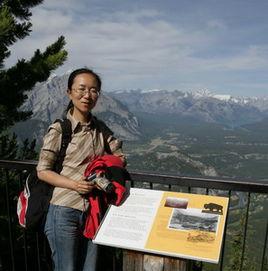主講課程
本科生:
旅遊景觀導論
旅遊規劃與公共政策
旅遊研究方法(雙語)
研究生:
旅遊系統分析
研究方向
系統動力學
旅遊規劃
資源管理
學術兼職
新疆維吾爾自治區乾旱區水循環與水利用重點實驗室兼職研究員(2010-2012)
中國旅遊地理專業委員會 副主任
研究課題
基金項目/Fund Project:
主持(PI):
國家基金,生活方式型旅遊小企業的時空格局及演變機制(項目編號41371156),2014-2017
國家基金,複雜理論與資源依賴性目的地的旅遊發展(項目編號40871060),2008-2010/
廣東省自然科學基金:複雜理論與廣東省城市旅遊增長研究(項目編號:04009787),2005-2007
國家旅遊局:2013年,促進生活方式型旅遊微小企業與旅遊目的地良性互動的政策研究, 2013-2014
新疆乾旱區水循環與水利用實驗室的開放基金課題:《瑪納斯河流域水資源有效配置與社會經濟環境》,2011-2012
參加:
國家基金委:雲南民族鄉村形態演化過程及機制研究,批准號51168019,2012-2016/
國家基金委,制度環境對我國旅遊產業增長影響的實證研究:基於時空視角的分析,批准號71203242, 2012-2015
國家基金委:旅遊發展與世界遺產地資源保護的互動機理及其政策評價模型研究,(項目批准號:70503007),2006-2008
國家基金委:城市旅遊理論體系、結構功能及遊憩商業區研究,批准號:40171027,2002-2004
教育部科學技術研究重點項目:珠江三角洲城市旅遊地生命周期及其調控研究,批准號:00101,2001-2003
國家基金委: 旅遊區域經濟影響評價模型及比較研究. 2005-2007
省部級規劃諮詢項目/ Consulting Projects)
國家旅遊局項目/ Projects of China National Tourism Administration:
副組長,《喀納斯景區旅遊總體規劃及主要節點概念規劃》,2007 ;
副組長,大香格里拉生態旅遊區規劃,2007 ;
副組長,西部旅遊投資規劃(西南片),2003/;
主要參與者,國家旅遊局《中國休閒旅遊城市標準》,2013
主要參與者,國家旅遊局、國家環保局《國家生態旅遊標準》,2005
省級項目(provincial level)
副組長,湖南省旅遊發展總體規劃,2006
副組長,湖北省旅遊發展總體規劃,2001
項目組長,海南省國際旅遊島與文明生態村深化發展研究,2010/
項目組長,海南省國際旅遊島生態旅遊戰略研究,2009其他規劃諮詢項目/ Other Planning&Consulting Projects
項目組長,商洛秦嶺生態旅遊核心區總體規劃,2013
項目組長,然烏湖國家公園規劃,2012
項目組長,柳州市魚峰區旅遊發展規劃,2012/
項目組長,蓮花台水庫旅遊總規,2011
項目組長,西藏昌都地區旅遊規劃(修編),2011
項目組長,宏村-西遞世界遺產地旅遊發展戰略
副組長,黃山市旅遊發展總體規劃
副組長,西雙版納旅遊發展總體規劃,2003
副組長,桂林市旅遊發展規劃,2000/
主要論著目錄
1.書籍/Books
徐紅罡,旅遊系統分析,南開大學出版社,2009
保繼剛, 徐紅罡, Alan A. Lew(主編),遺產旅遊學術論文集[M]. 中國旅遊出版社,2008
保繼剛, 徐紅罡, Alan A. Lew(主編).《社區旅遊與邊境旅遊》學術論文集[M]. 中國旅遊出版社,2006年..
徐紅罡, Alan A. Lew(主編).事件旅遊與旅遊目的地發展管理國際研討會論文集[M].中國旅遊出版社, 2005年.
主編:保繼剛,劉德齡,鍾新民 副主編: 徐紅罡. 《開發中國家旅遊規劃與管理國際研討會(桂林)》學術論文集[M]. 北京旅遊出版社,2002年
2.論文代表作/ Representative Articles
SSCI, SCI刊物/ SSCI, SCI Journals
1.Honggang Xu, Xiaojuan Wan & Xiaojun Fan; Rethinking authenticity in the implementation of China's heritage conservation: the case of Hongcun Village, 2014, 5
2.Honggang Xu, Chaozhi Zhang & Alan A. Lew;Tourism geography research in China: institutional perspectives on community tourism development, 2014,5
3.Wang, CP. Xu HG. The role of local government and the private sector in China's tourism: The issue of sustainability, Tourism Management 2014,45(12)
4.Huang LY, Gursory, D. Xu HG. Impact of personality traits and involvement on prior knowledge; Annals of Tourism Research; 2014,(48)
5.Wang, SS, Xu, HG. Influence of place-based senses of distinctiveness, continuity, self-esteem and self-efficacy on residents' attitudes toward tourism, Tourism Management, 2014
6.Wu YF, Xu HG, Lew A. Consumption-Led Mobilized Urbanism: Socio-Spatial Separation in the Snowbird City of Sanya. Motilities, (in press)
7.Xu HG, Sofield, T. Sustainability in Chinese tourism development policies. Current Issues in Tourism. (in press)
8.Xu H, Cui Q, Sofield T, Li FMS: Attaining harmony: understanding the relationship between ecotourism and protected areas in China. JOURNAL OF SUSTAINABLE TOURISM 2014, 22:1131-1150.
9.Xu Honggang, Cui Qingming, Roy Ballantyne and Jan Packer. Effective Environmental Interpretation at Chinese Natural Attractions: The Need for an Aesthetic Approach, Journal of Sustainable Tourism, 2012. DOI:10.1080/09669582.2012.681787, (SSCI)
10.Xu Honggang, Ma Shaoyin. Regional Environment of Destination and the Entrepreneurship of Small Tourism Businesses: A Case Study of Dali and Lijiang of Yunnan Province. Asia Pacific Journal of Tourism Research, 2012, 2014, 19:144-161. (SSCI)
11.Sun, XX,. Chi G.Q. Xu HG, Developing Destination Loyalty: the Case of Hainan Island. Annuals of Tourism Research. 2013,(43)
12.Dai Shanshan, Xu Honggang, Noel Scott, Peiyi Ding and Eric Law. Distortions in Tourism Development in the Dali Autonomous Region, China. Asia Pacific Journal of Tourism Research. 17(2), 2012.(SSCI)
13.DAI,SS , LanHai LI, HongGang XU , XiangLiang PAN , XueMei LI. A system dynamics approach for water resources policy analysis in arid land: a model for Manas River Basin. Journal of Arid Land. 2012. (SCI)
14.Wang, C. P., Xu, H. G., 2011. Government intervention in investment by Chinese listed companies that have diversified into tourism. Tourism Management. DOI:10.1016/ j.tourman.2011.01.012. (SSCI)
15.Honggang Xu; Shanshan Dai. A system dynamics approach to explore sustainable policies for Xidi, the world heritage village, Current Issue in Tourism. DOI:10.1080/13683500.2011.610499. Available online: 30 Sep 2011, (SSCI)
16.Lanhai Li , Honggang Xu, Xi Chen and S. P. Simonovic. Streamflow Forecast and Reservoir Operation Performance Assessment Under Climate Change, Water Resources Management, 24(1), 2010 (SCI)
17.C. Z. Zhang; H. G. Xu; B. T. Su; C. Ryan, Visitors' perceptions of the use of cable cars and lifts in Wulingyuan World Heritage Site, China. Journal of Sustainable Tourism,17(5), 2009 (SSCI)
18.Honggang Xu, Peiyi Ding, Jan Packer. Tourism Research in China: Understanding the Unique Cultural Contexts and Complexities. Current Issues in Tourism, 11(6), 2008 (SSCI)
19.Xu Honggang, Bao Jigang, and Zhou Changchun. Effectiveness of Regional Tourism Integration—Case of Quadrangle Economic Cooperation Zone in Great Mekong Region. Chinese Geographical Science. 16(2), 2006 (SCI)
20.Steve Arquitts, Honggang, Xu. A system dynamics analysis of boom and bust in the shrimp aquaculture industry. System Dynamics Review. 21(4): 305-324. 2005(SSCI)
21.Honggang Xu. Exploring Effective Policies For Underground Water Management In Artificial Oasis: A System Dynamics Analysis of a Case Study of Yao Bao Oasis Environmental Science,13(4), 2001 (SCI)
22.Saeed, K and Ali. Effectiveness of Infrastructure Service Delivery through Earmarking: The Case of Highway Construction in China. System dynamics Review, 14(2).1998. (SSCI)
CSSCI期刊/CSSCI Journals
23.崔慶明;徐紅罡;楊楊 ,世俗的朝聖:西藏旅遊體驗研究,旅遊學刊,2014年第2期
24.徐紅罡;唐周媛 旅遊發展背景下民族手工藝企業家創業過程研究,西南民族大學學報(人文社會科學版),2014年09期
25.保繼剛,翁時秀,徐紅罡,朱峰,盧凱翔, 旅遊地理學學科建設與高層次人才培養——基於“知識溢出”的審視,中國大學教學,2014年08期 CSSCI
26.崔慶明, 徐紅罡(2012). 野象的迷思:野象穀人—象衝突的社會建構分析. 旅遊學刊, 27(5): 49-56.
27.張機, 徐紅罡(2012). 民族旅遊中的主客互動研究:基於符號互動論視角.思想戰線, 38(3):116-119.
28.徐紅罡, 馬少吟(2012). 旅遊小企業的創業機會識別研究——桂林陽朔西街案例. 旅遊學刊, 27(8): 18-26
29.彭麗娟, 徐紅罡, 劉暢(2011). 基於社會交換理論的西遞古村落私人空間轉化機制研究人文地理.26(5):29-33.
30.徐紅罡, 萬小娟, 范曉君(2012). 從“原真性”實踐反思中國遺產保護——以宏村為例. 人文地理, 27(1): 107-112.
31.黃家玲, 徐紅罡, 代姍姍, 李軍.(2011). 基於社會屬性和旅遊經歷的旅遊者生態意識研究——以海南旅遊者為例 旅遊科學, 25(6):46-54.
32.吳悅芳,徐紅罡(2010). 大理古城旅遊房地產的發展及社會文化影響研究. 人文地理,25(4): 67-71.
33.梁微, 徐紅罡, Rhodri Thomas (2010). 大理古城生活方式型旅遊企業的動機和目標研究. 旅遊學刊, 25(2): 47-53.
34.王彩萍,徐紅罡(2009). 重大事件對中國旅遊企業市場績效的影響:以2008年為例. 旅遊學刊.24(7):58-65.
35.王利偉,徐紅罡,張朝枝(2009). 武陵源遺產地旅遊產業集群的特徵和演變.經濟地理29(6):1029-1035.
36.王利偉,徐紅罡 (2009). 武陵源世界遺產地的旅遊網路構建和發生演變初探.旅遊科學. 23(4): 19-25.
37.王彩萍, 徐紅罡(2008). 旅遊企業多元化經營的經濟後果分析. 旅遊學刊, 23(7): 18-22.
38.Trevor Sofield, 徐紅罡(2008). 旅遊與人類學:研究與實踐. 思想戰線. 34(4): 38-43.
39.楊彥峰,徐紅罡(2007). 對我國生態旅遊標準的理論探討. 旅遊學刊, 4(22): 73-78.
40.徐紅罡, 相陣迎(2007). 珠海旅遊產業集群研究. 人文地理, 22(6): 76-80.
41.徐紅罡(2006).資源型旅遊目的地增長極限的理論模型.中國人口 資源與環境, 16(5): 35-40 (人大旅遊管理收錄)
42.徐紅罡(2006). 生態旅遊地發展的模型研究. 旅遊學刊, 21(8): 75-80.
43.張朝枝,徐紅罡, 保繼剛(2005). 世界遺產地內索道乘客的特徵、滿意度及其影響——武陵源案例研究. 旅遊學刊. 20(3):33-37.
44.徐紅罡(2005). 城市旅遊與城市發展的動態模式探討. 人文地理, 20(1): 6-9.
45.徐紅罡, 龍江智(2005). 城市旅遊地生命周期的模式研究.城市規劃學刊.(2):70-74.
46.徐紅罡,鄭海燕,保繼剛(2005). 城市旅遊地生命周期的系統動態模型. 人文地理, 20(5): 12-16.
47.徐紅罡(2005). 文化遺產旅遊商業化的路徑依賴理論模型. 旅遊科學. 19(3):74-79.
48.徐紅罡(2004). 旅遊業中的二元結構及公共政策研究. 思想戰線. 30(1): 96-100.
49.徐紅罡,保繼剛(2004). 系統動力學在旅遊規劃中的運用. 經濟地理.23(5): 704-709.
其他重要刊物:
50.Aram Son, Honggang Xu (2013). Religious food as a tourism attraction: the roles of Buddhist temple food in Western tourist experience, Journal of Heritage Tourism, 8(2-3): 248-258.
51.Cui Qingming, Xu Honggang, Geoffrey Wall (2012). A Cultural Perspective on Wildlife Tourism in China. Tourism Recreation Research. 37(1). Best paper of the year award
52.Xu Honggang, Wu Yuefang, Geoffrey Wall (2012). Tourism Real Estate Development as a Policy Tool for Urban Tourism: A Case Study of Dali and Lijiang, China. Journal of China Tourism Research. 8(2): 174-193.
53.徐紅罡, 薛丹(2011). 旅遊目的地仿生學空間關係研究——以安徽省古村落西遞、宏村為例.地理科學. 32(12): 1518-1524.
54.代姍姍, 徐紅罡, 李軍(2011). 基於EKC假說的經濟發展與自然保護區關係分析.中山大學學報(自然科學版). 50(1): 119-122.
55.代姍姍, 唐周媛, 徐紅罡 (2011). 中國入境旅遊旅遊者購物消費的省際差異及影響因素, 地理科學. 31(1): 74-80.
56.徐紅罡,吳悅芳,彭麗娟(2010). 古村落旅遊地游線固化的路徑依賴——世界遺產地西遞、宏村實證分析. 地理研究. 29(7): 1324-1334.
57.Wu Yuefang, Xu Honggang, Andrew Englen. The tourism development in Lijiang. Journal of Event and Tourism Policy Study. 3(1): 63-86.
58.Wang Caiping, Xu Honggang (2009). Is Diversification a Good Strategy for Chinese Tourism Companies? Journal of China Tourism Research, 5(2).
59.Honggang Xu (2007). Tourism and Regional Development in China. Geographische Rundschau. 3.
60.徐紅罡,田美蓉(2006). 城市旅遊的增長機制研究. 中山大學學報(自然科學版).45(3):95-99
61.保繼剛, 徐紅罡, 戴光全(2002).“告別三峽游”的影響及理論解釋. 地理研究. 21(5): 608-616.
62.Honggang Xu, Tang Zhouyuan, and Ni Sisi, The Impact of Cultural Tourism on the Innovation of Ethnic Handicraft Production in Dali, China, Asia Pacific World,2014,5(2)

